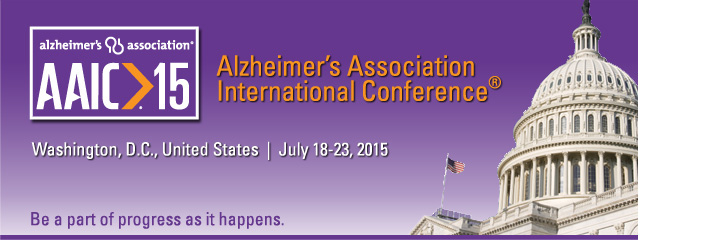
In July over 4000 researchers from 60 countries came together in Washington D.C. for the Alzheimer’s Association International Conference (AAIC) 2015; the world’s largest gathering of researchers focused on Alzheimer’s disease and other dementias.
The conference opened with a plenary talk exploring ‘What will it take to end Alzheimer’s disease?’ As the proportion of people with dementia doubles for every five year increase in age, being able to delay the age of onset by five years is estimated to halve the number affected. The field continues its search for the elusive but much needed disease modifying therapy for Alzheimer’s disease. A lively debate saw Nick Fox and Rachelle Doody discuss the relative importance of disease modification for therapies in clinical practice. This set the scene for Paul Aisen to announce the most publicised news of the conference, the open label extension of the Phase III Solanezumab Expedition Program in mild Alzheimer’s disease. In brief this delayed-start analysis pooling data from two previous studies provided evidence that, whilst the effects of Solanezumab on cognitive decline were relatively small, there appeared to be a significant and sustained benefit in those who had been on active therapy the longest, consistent with a disease modifying effect. It is hoped that EXPEDITION 3, a multicentre Phase 3 solanezumab trial in mild AD expected to report in December 2016, and several ongoing studies in pre-symptomatic disease, will shed further light on these promising early findings.
Molecular PET imaging using amyloid and tau tracers in patients and pre-symptomatic individuals continues to be an area of huge interest, with ongoing studies to optimise clinical utility, standardise analytical techniques for assessing longitudinal change, and understand how results relate to other biomarkers. Michael Scholl won the Alzheimer’s Imaging pre-conference prize for his presentation on in-vivo Braak staging using 18F-AV 1451 Tau PET imaging. Studies examining tau PET in atypical presentations of Alzheimer’s disease showed that tau deposition is more topographically related to regional hypometabolism than amyloid deposition. A comprehensive study of amyloid PET and CSF amyloid, demonstrated that the two modalities seem to be highly comparable.
There was considerable interest in novel CSF biomarkers for aiding preclinical diagnosis, predicting disease progression and response to treatment. CSF Neurogranin, a post synaptic protein, is emerging as a promising biomarker of synaptic dysfunction, evidence that it may be an early disease marker and may predict progression from mild cognitive impairment (MCI) to dementia. Henrietta Wellington from University College London won the student poster prize for demonstrating that Neurogranin elevation may be specific to AD. With regards to novel analytical techniques, a number of elegant CSF proteomic studies demonstrated the utility of mass spectrometry in biomarker discovery and development. Kaj Blennow from the University of Gothenburg presented data suggesting an impressive performance from a fully automated ELISA platform for biomarker quantification between centres. From a clinical perspective, a large study of over 2000 individuals undergoing lumbar puncture (LP) in Amsterdam provided much needed data on the safety and risks of routine LP: low rates of headache and other complications were reported.
Bruce Miller addressed ‘Frontotemporal Dementia: A quarter century of progress’ and the importance of being able to predict molecular pathology from patient phenotype was emphasized now that drug therapies for FTD are beginning to emerge. Arguably the most promising are histone deacetylase (HDAC) inhibitors for individuals carrying the progranulin gene mutation. In her plenary, Li Gan explained that even a very modest boost in progranulin levels of 5-8% can be neuroprotective in animal models.
Work on vascular cognitive impairment demonstrated that neuropathologically determined microinfarcts are underdiagnosed on conventional MRI and that these lesions may contribute to the degree of clinical heterogeneity seen in amyloid positive individuals. Other personal highlights included studies of the ‘oldest old’ cognitive super-agers, the use of ‘big data’ in early detection of AD and the rise of retinal imaging for studying neurodegenerative disease.
A professional interest day organised by the Alzheimer’s Association International Society to Advance Alzheimer’s Research and Treatment (ISTAART) provided the opportunity for Professional Interest Areas to meet and collaborate. At the Neuroimaging PIA, Michael Grothe summarised neuroimaging advances over the last year to the Alzheimer’s Imaging Consortium, and Alan Evans’s plenary on the ‘Human Connectome’ presented how functional brain networks defined with resting-state functional magnetic resonance imaging can be recapitulated using measures of correlated gene expression in post mortem brain tissue. With further work, this could help explain the basis of regional vulnerability in neurodegenerative disease. At the blood-based biomarkers PIA there was discussion about the challenges that continue to face the field of blood biomarkers. The online resource Alzbiomarker (www.alzforum.org/alzbiomarker), which collates knowledge of the wet biomarker field and provides meta-analysis data for key fluid biomarkers, was unveiled and will go live in Autumn 2015.
Junior researchers benefited from pre-conference sessions on basic neuropathology, animal models, and an introduction to neuroimaging in dementia. ISTAART also organised lunch time workshops on ‘How to write a grant’ and ‘How reviewers view your manuscript’ which included lots of practical tips for writing and submitting scientific papers from journal editors.
Almost 500 oral presentations and 1,500 poster presentations were given during the five day main conference. The focus remains twofold: establishing a better understanding of disease pathophysiology to identify new therapeutic targets; and developing and refining sensitive and specific biomarkers to establish the earliest onset of clinically relevant Alzheimer’s pathology and to track clinically meaningful changes in response to novel therapies. Whilst there are undoubtedly many hurdles and much work remaining to be done, there are grounds for cautious optimism that drugs including Solanezumab and HDAC inhibitors may herald the start of a new era of disease modification in Alzheimer’s disease and other neurodegenerative dementias.